Cashmerette pants patterns like the Ames Jeans and the Calder Pants & Shorts come with two pelvis options to help you get a great fit right out of the packet. Here’s how to choose between the apple pelvis fit and the pear pelvis fit.
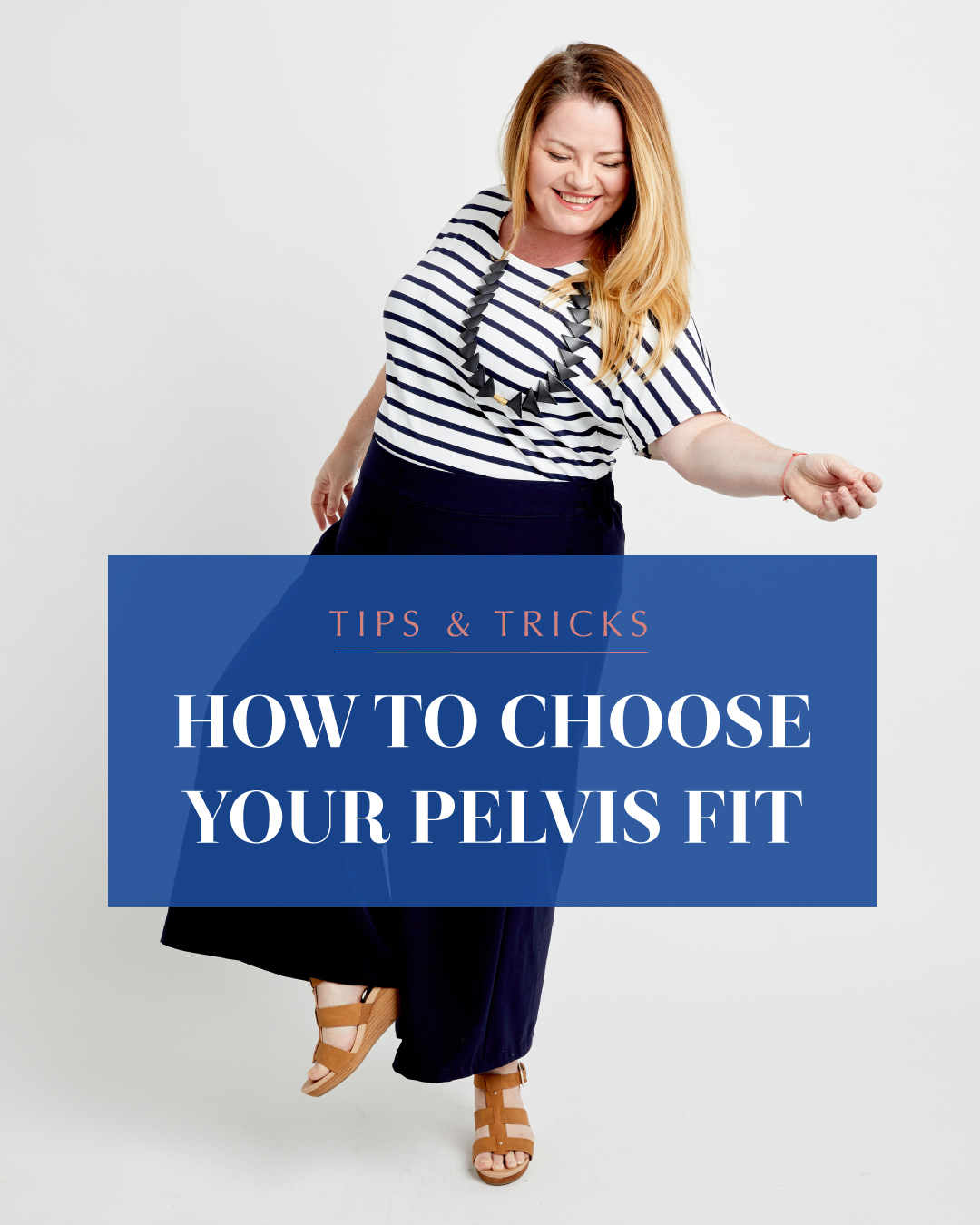
Comparing your body type to a piece of fruit is always a bit surreal—I’m a golden delicious myself—but we’ve found it’s a helpful way to visualize the two pelvis fits that we offer. The fruit system of classifying body types is far from perfect, but it’s a helpful way to create two different fits that would be easily understood by sewists. We found that our testers had much better success starting off with their pelvis fit than a standard “one size fits all” pattern.
Our pants patterns that include the apple and pear pelvis fits, such as the Ames Jeans and the Calder Pants & Shorts, include both pelvis options in the pattern. That way, you don’t have to worry about choosing your pelvis fit before getting the pattern, and if you try one pelvis option and decide you need the other instead, you already have it!
One important thing to keep in mind: the tummy fit is the same for both pelvis fits. The differences between the two pelvis are in the waist to hip curve and in the back.
Our two pelvis fits have slightly different measurements, which you can see in the size chart for the pants patterns. For example, here’s the size chart for the Calder Pants & Shorts:
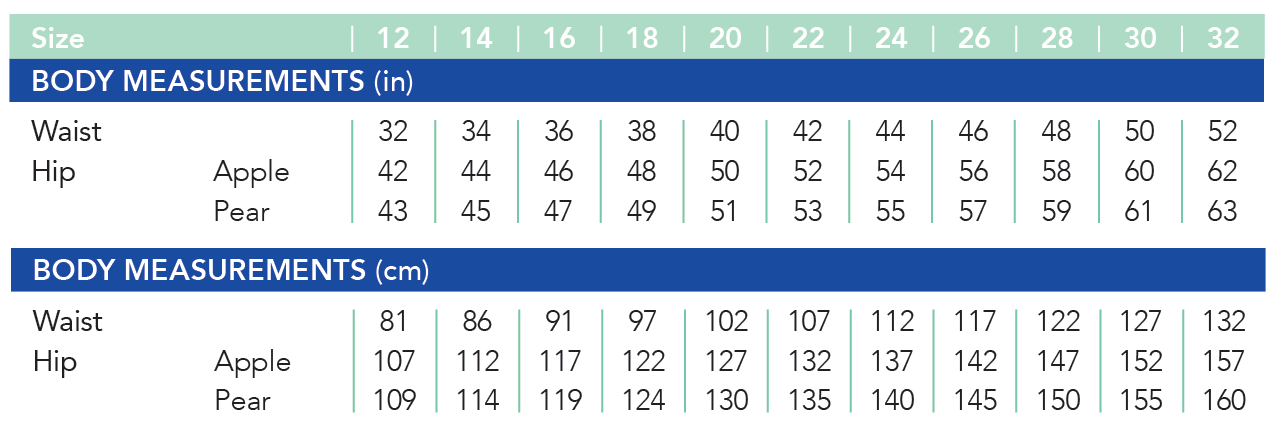
This should help you identify your pelvis fit based on your measurements, but if you’re still not sure, here are some tips:
The Apple Pelvis Fit
You are likely going to be best in the “apple” pelvis fit if:
- Typically, you find pant waistbands are constricting, and the back bum/thigh area is a bit baggy.
- Typically, pant waistbands cut in when the pants fit your hips.
- You have a straighter hip curve rather than a very curved one.
- You have a low hip-to-waist ratio.
Here you can see that the “curve” between Andrea’s waist and hip is pretty minimal–she has a proportionately large waist and small hips. We used the apple pelvis fit for her Calder Pants.
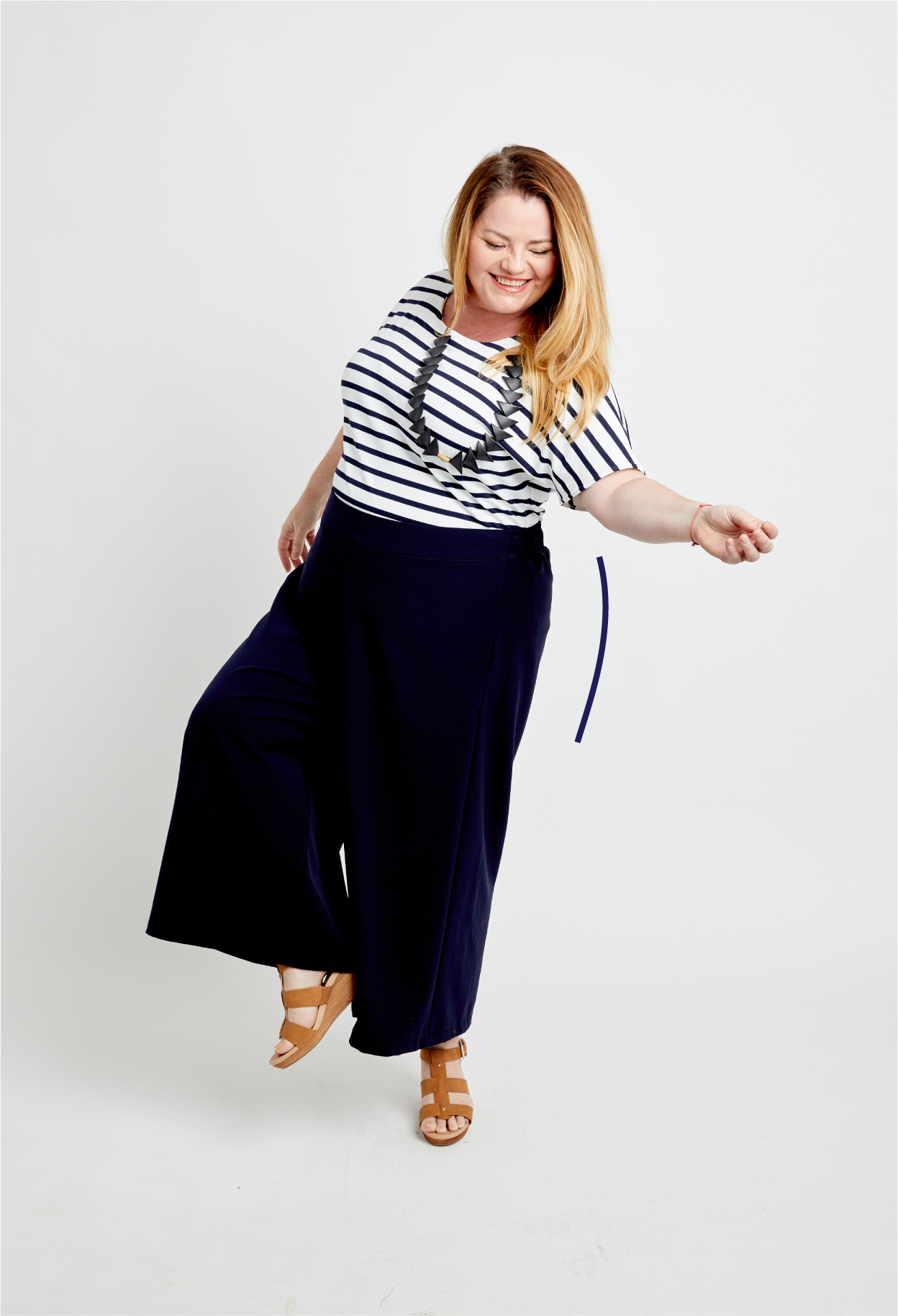
The Pear Pelvis Fit
You are likely going to be best in the “pear” pelvis fit if:
- Typically, you find that pant waistbands gape at the back, but are tight through the hips. Conversely, when pants fit you in the hips, the waistband is much too big.
- You have a very curved hipline.
- You have a higher hip-to-waist ratio.
Here you can see that Dawn has a more pronounced curve between her waist and her hip. We used the pear fit for Dawn’s Ames Jeans.
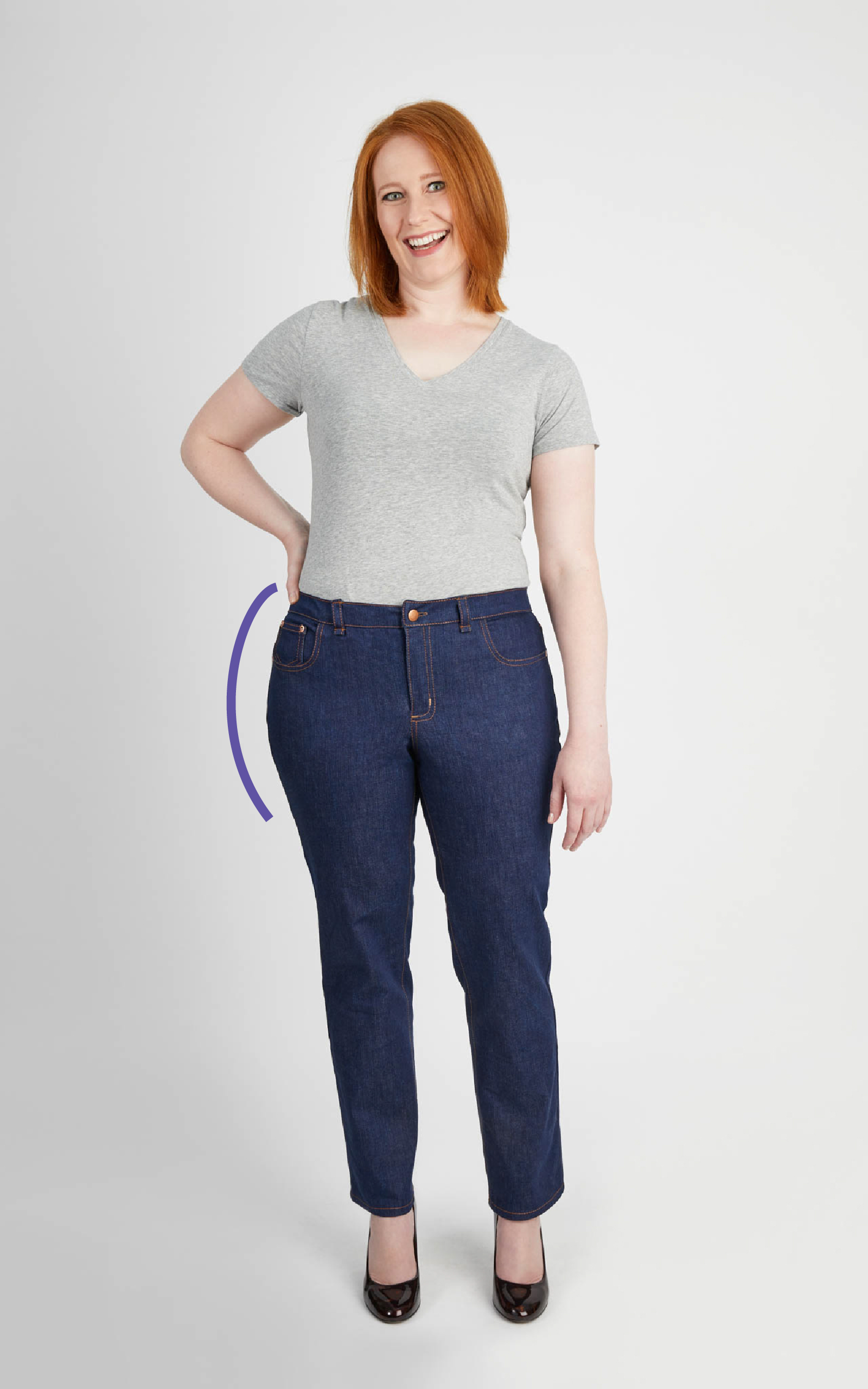
Still not sure which pelvis option to choose?
Here are some additional thoughts:
- It’s always a good idea to make a muslin first! And remember to baste your side seams before you do final stitching/top-stitching, so you will have time to make adjustments.
- Grading between sizes is always an option, so don’t worry if you’re “more of an apple” or “more of a pear” than the pants are designed for.
- If you make the pear shape pelvis, you can always take it in at the hips later when you baste.
- If the existing Cashmerette waist/hip ratio usually works for you, the apple is likely to fit you best.
- If you’re an hourglass with a defined waist, then you’re probably going to be the pear.
- Remember, most of us have to make some adjustments to most patterns. Pick a fit as a good starting point, but you’ll likely have to make further changes, so don’t get too worried about having a perfect fit right away.
We hope that helps you choose your ideal pelvis fit! If you have any questions, let us know in the comments below.


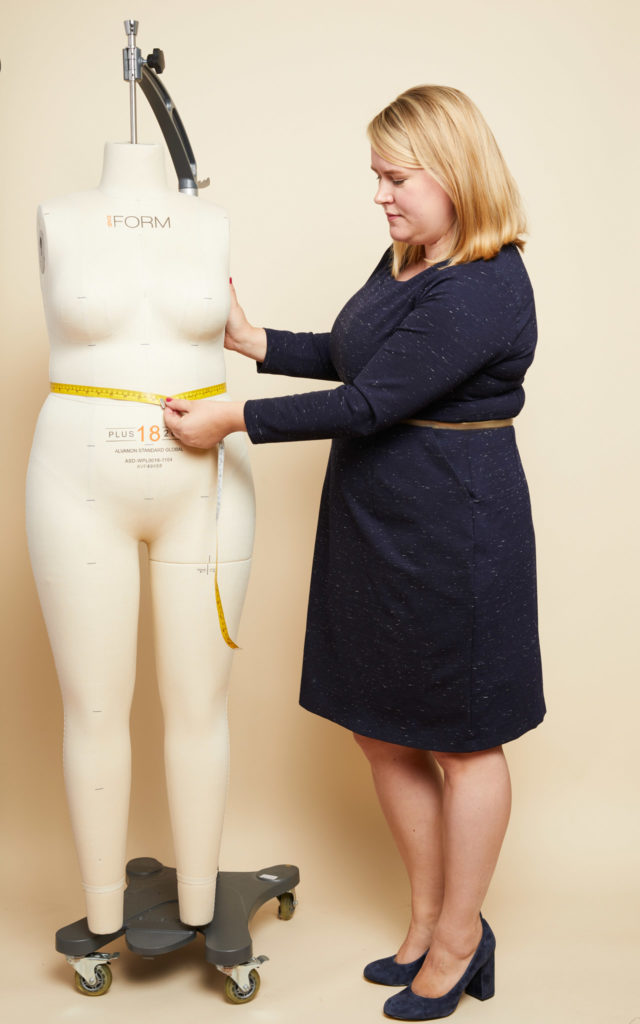
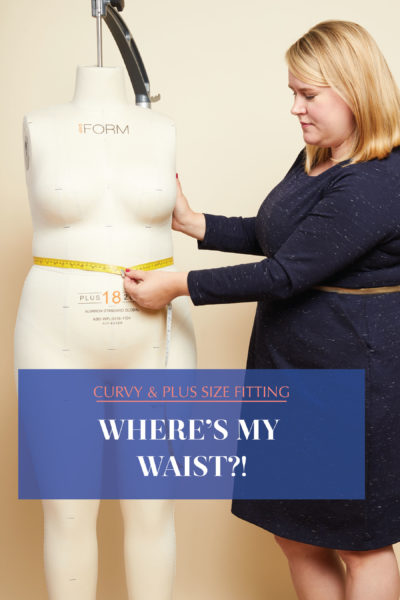
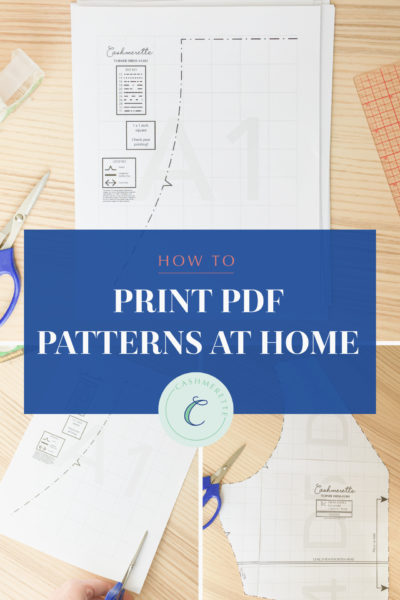
Does our pelvis type, apple or pear, change when you gain or lose weight? Many of us have gained “pandemic pounds” this year and have this question. For me I seem more pear shaped than I used to, with my hips widening to an alarming degree. But my waist has also grown. Extra weight just accumulated all over and I am not sure what I am. If I take my new (temporary) measurements will they still give me a hint as to which pelvis style I should try first? Assuming that I succeed in returning to me pre-pandemic weight and size (I want this, not because other people say I should) then will I still use the same “fruit” pelvis shape as now? This is seriously confusing. Jenny, you must have thought about this as you blog about baby weight and you now often refer to the changes you underwent since giving birth. Who would know better? Won’t you please shed some light. Thank you so much.
People put on weight in different ways, so there’s no absolute answer to whether people get more apple or pear when you change weight. For instance, I always put everything on around my waist, making me more of an “apple”. But a lot of people put weight on their bum, which makes them more “pear”, or could move them from being an apple into a pear. So it’s not about what weight you are, it’s still about your waist and hip ratio as it explained in the blog post.
Could you please post a drawing of the apple and pear crotch curves so we can see the difference that way? Thanks.
I’ve learnt things from this first visit to site and although it’ll be useful to learn i don’t like what I learnt. Do to what I call baby blankets from a very big baby 10 year ago my belly area is 2 to 3 sizes bigger than rest. Thought I’d be one. Its kinda put me off with sizing no
My lower tummy or hi hip is 10 inches bigger than my waist and to make matters more complicated I have thin legs. I have given up on making pants for myself. Would love advice.
I have the Calder pattern but haven’t made it yet. I have the same problem as Debbie; hips are way bigger than waist, plus I’m short; just over 5’1″. To make matters even worse, I have “Big Bubble” hips and butt–jut out immediately from the waist which makes grading difficult. I can wear a 14-18 top with hip alteration, depending on pattern designer/manufacturer, but need at least a 3-5X bottom. I have to extensively alter every pattern and have difficulty getting the hip/butt curve to look right. Using the Appple/Pear comparison should give me a better starting point. It’s also easier now that we have the layers option. I can print a couple layers closest to measurements and use them to recreate the curves, but it’s still a challenge with that much difference in sizes. One additional thought: it is very, very helpful if the intended/designed bust, waist, and hip placement is noted on the pattern, which some designers are no longer adding. I know we all have different body shapes and heights, but those placements give a starting point that is helpful for alteration. I always, always have to measure, compare both width and height to the actual pattern measurements and add width, but it’s much harder if the intended bust/waist/hip placement is not given for the particular pattern design, especially if the garment is designed to fit loosely. Yes, the looseness covers a lot, but it’s the overall proportion and design shape that get skewed if those placements are ignored. I have several garments that don’t look all that much like the design because those design points are now in different places. Maybe I need to upgrade my guessing skills? LOL I’ve held off on making the Cashmerette patterns that I’ve bought because many are designed for knits (which show every lump and bump on me) but now I feel better about getting started.
Hi! You’ll find the bust, waist and hip indicated with notches on our patterns, including the Calder (in that case, the waistband is the waist level).
I love this concept for the starting point in pants. I think I am a rectangle though and am not sure what I would use for my starting point. I have a 34 inch waist and 40 inch hips. I have thick legs also. I have a pretty flat stomach so my inches are more in my width. Any advice? Thanks
Hi Pam! You can use our handy size calculator to get a personalized size recommendation: https://cashmerette.com/sizing
Thanks,
Ayelet at Cashmerette
I have a 42″ waist and 47″ hip. The size chart puts me at a 22 in the waist (which is disheartening; I’m a 14/16 in most commercially-made pants) and a 16 pear based on the hip. Is it really possible to grade 4 entire sizes? Or am I reading this entirely wrong?
What I was taught in my sewing class was DO NOT COMPARE shop sizes to designer sizes. Each designer has their own sizing, thus you need to re measure yourself each time you make something new. The reason we make clothes is likely because shop clothes never sit of fit correctly and we want what we make to be comfortable. So in my book, don’t get stressed about the different sizes, make the size that works and sits beautifully on your body (be it big or small). I hope this eases your mind.
Hi Esther–like Sonya said, sewing pattern sizes are different from ready-to-wear sizes, so it’s best to go by your measurements. We have resources for grading between sizes here: cashmerette.com/grading
-Ayelet at Cashmerette